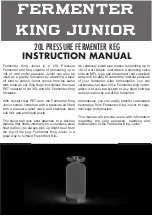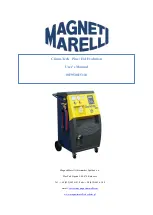
17
8
TROUBLE SHOOTING
FAULT
CAUSE
SOLUTION
1 No power
Mains power switch is switched on,
but the display does not light up.
The power supply (feeder) to the
machine is interrupted or
machine’s internal fuse defective
Check the mains power cable and
mains voltage or replace fuse with
a suitable fuse of the same type
and value.
2 No welding current
Mains power switch is switched on,
but the machine does not weld.
The power supply (feeder), from
the machine to the hand-piece is
interrupted.
Check the connections (connector
and socket).
Mains power switch is switched on,
but the machine does not weld.
Bad, or no connection to
protective ground
Create a connection between the
machine and the work piece.
Attach one of the terminal clamps
(i.e. crocodile clip) securely to a
part of the work piece.
3 No welding current
Mains power switch is switched on Problem caused by fault current
(abnormal current in an electric
circuit due to a fault, usually a
short circuit or abnormally low
impedance path).
Switch the machine off and then
on again via the mains power
switch.
If the problem persists, the
machine will need servicing,
please contact your dealer.
4 Circuit breaker is triggered, or
mains fuse blows
The mains fusing is too weak or
the wrong circuit breaker is being
used.
Correctly fuse the mains power
supply.
Mains fuse blows as soon as the
machine is switched on.
5 Bad welding result / bad welding
characteristics
The wrong inert gas is being
used.
The machine will need servicing,
please contact your dealer.
Use Argon inert gas.
Wherever possible, use Argon
with a purity of 99,996% i.e.
“Argon 4,6”.
6 Oxidation and the forming of
soot
7 Welding spots are heavily
oxidised.
The gas pressure is set too high.
The wrong inert gas is being
used.
Reduce the flow rate - ca. 2
L/min. is sufficient.
Use Argon inert gas.
Wherever possible, use “Argon
4,6”.
8 Tungsten inclusions in the
work-piece
The electrode is being pressed
too hard onto the work piece.
Work using no pressure, or only
the slightest of pressure; do not
apply force !
9 Tungsten electrode „sticks“ to
the work piece when welding
The electrode is being pressed
too hard onto the work piece.
Work using no pressure, or only
the slightest of pressure; do not
apply force !
10 Tip of tungsten electrode melts
off as soon as welding starts.
The angle, at which the electrode
is sharpened, is too acute.
Recommended grinding angle is
ca. 15°.
11 Discharge of static electricity
across the surface of the
machine.
Due to special local conditions
Use a special antistatic mat for
the working area.
12 Glare protection system
(Shutter) in not working
The plug of the glare protection
system is not correctly connected.
Insert the plug of the glare
protection system into the socket
marked “Shutter/Welding Shield”
(Fig 2 no.13 page 7).
13 The machine welds immediately
after the electrode contacts the
work piece (no delay for gas to
flow, prior to the welding
process)
Technical malfunction
Immediately take machine out of
operation. It must be shut down
and removed from the power
supply; it must also be secured
against accidental re-operation or
activation.
The machine will need servicing,
please contact your dealer.


































